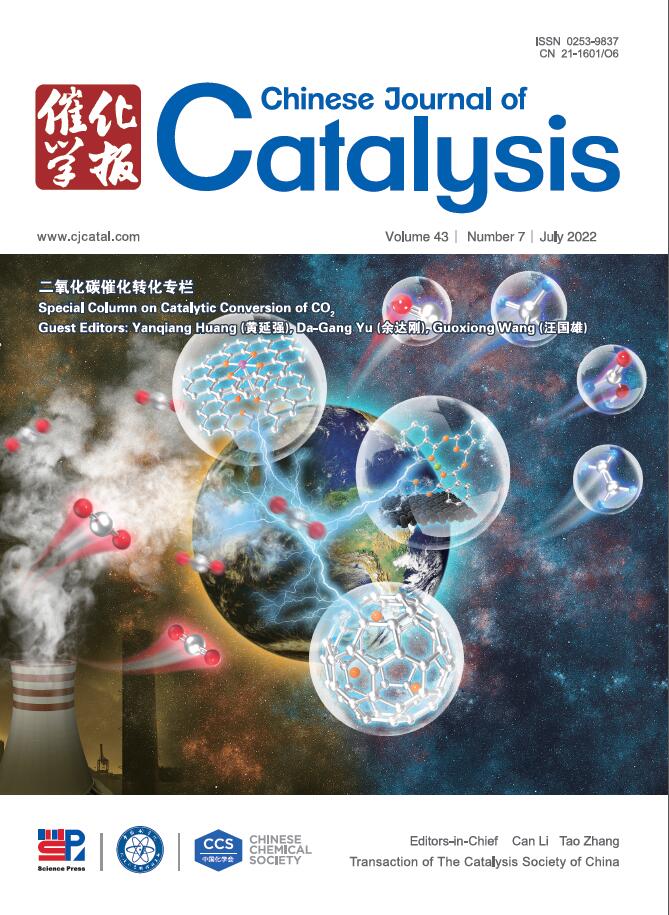Carbon diffusion mechanism as an effective stability enhancement strategy: The case study of Ni-based catalyst for photothermal catalytic dry reforming of methane
IF 15.7
1区 化学
Q1 CHEMISTRY, APPLIED
引用次数: 0
Abstract
Photothermal catalytic methane dry reforming (DRM) technology can convert greenhouse gases (i.e. CH4 and CO2) into syngas (i.e. H2 and CO), providing more opportunities for reducing the greenhouse effect and achieving carbon neutrality. In the DRM field, Ni-based catalysts attract wide attention due to their low cost and high activity. However, the carbon deposition over Ni-based catalysts always leads to rapid deactivation, which is still a main challenge. To improve the long-term stability of Ni-based catalysts, this work proposes a carbon-atom-diffusion strategy under photothermal conditions and investigates its effect on a Zn-doped Ni-based photothermal catalyst (Ni3Zn@CeO2). The photothermal catalytic behavior of Ni3Zn@CeO2 can maintain more than 70 h in DRM reaction. And the photocatalytic DRM activity of Ni3Zn@CeO2 is 1.2 times higher than thermal catalytic activity. Density functional theory (DFT) calculation and experimental characterizations indicate that Ni3Zn promotes the diffusion of carbon atoms into the Ni3Zn to form the Ni3ZnC0.7 phase with body-centered cubic (bcc) structure, thus inhibiting carbon deposition. Further, in-situ diffuse reflectance infrared Fourier transform (DRIFT) spectroscopy and DFT calculation prove Ni3Zn@CeO2 benefits the CH4 activation and inhibits the carbon deposition during the DRM process. Through inducing carbon atoms diffusion within the Ni3Zn lattice, this work provides a straightforward and feasible strategy for achieving efficient photothermal catalytic DRM and even other CH4 conversion implementations with long-term stability.
碳扩散机制作为一种有效的稳定性增强策略:以镍基催化剂光热催化甲烷干重整为例
光热催化甲烷干重整(DRM)技术可以将温室气体(即CH4和CO2)转化为合成气(即H2和CO),为减少温室效应和实现碳中和提供了更多的机会。在DRM领域,镍基催化剂因其成本低、活性高而受到广泛关注。然而,镍基催化剂上的碳沉积总是导致快速失活,这仍然是一个主要的挑战。为了提高镍基催化剂的长期稳定性,本工作提出了光热条件下的碳原子扩散策略,并研究了其对掺杂锌的镍基光热催化剂的影响(Ni3Zn@CeO2)。Ni3Zn@CeO2在DRM反应中能保持70 h以上的光热催化行为。而Ni3Zn@CeO2的光催化DRM活性比热催化活性高1.2倍。密度泛函理论(DFT)计算和实验表征表明,Ni3Zn促进碳原子向Ni3Zn扩散,形成具有体心立方(bcc)结构的Ni3ZnC0.7相,从而抑制碳沉积。此外,原位漫反射红外傅里叶变换(DRIFT)光谱和DFT计算证明Ni3Zn@CeO2有利于CH4活化,抑制DRM过程中的碳沉积。通过诱导碳原子在Ni3Zn晶格内扩散,这项工作为实现高效的光热催化DRM甚至其他长期稳定的CH4转化实现提供了一种简单可行的策略。
本文章由计算机程序翻译,如有差异,请以英文原文为准。
求助全文
约1分钟内获得全文
求助全文
来源期刊

Chinese Journal of Catalysis
工程技术-工程:化工
CiteScore
25.80
自引率
10.30%
发文量
235
审稿时长
1.2 months
期刊介绍:
The journal covers a broad scope, encompassing new trends in catalysis for applications in energy production, environmental protection, and the preparation of materials, petroleum chemicals, and fine chemicals. It explores the scientific foundation for preparing and activating catalysts of commercial interest, emphasizing representative models.The focus includes spectroscopic methods for structural characterization, especially in situ techniques, as well as new theoretical methods with practical impact in catalysis and catalytic reactions.The journal delves into the relationship between homogeneous and heterogeneous catalysis and includes theoretical studies on the structure and reactivity of catalysts.Additionally, contributions on photocatalysis, biocatalysis, surface science, and catalysis-related chemical kinetics are welcomed.
 求助内容:
求助内容: 应助结果提醒方式:
应助结果提醒方式:


